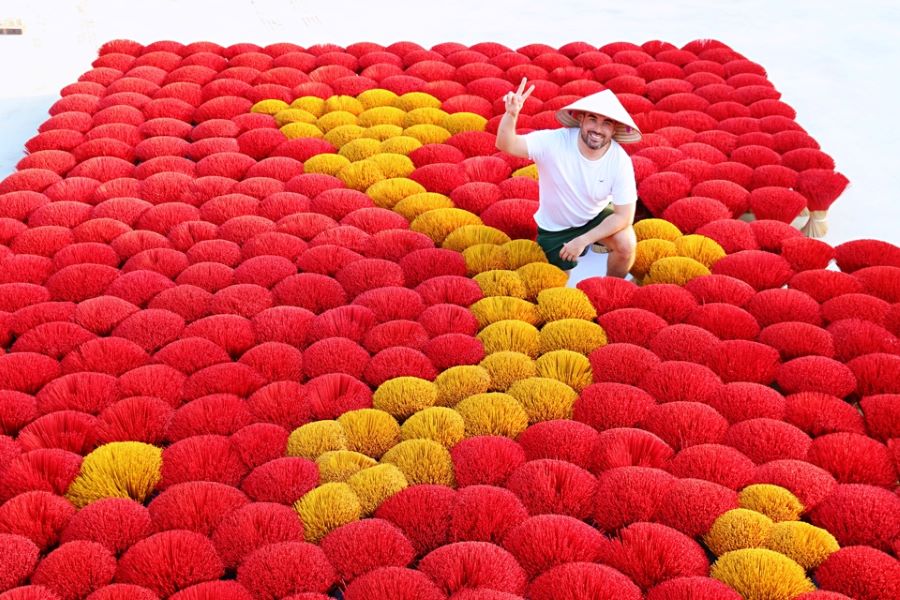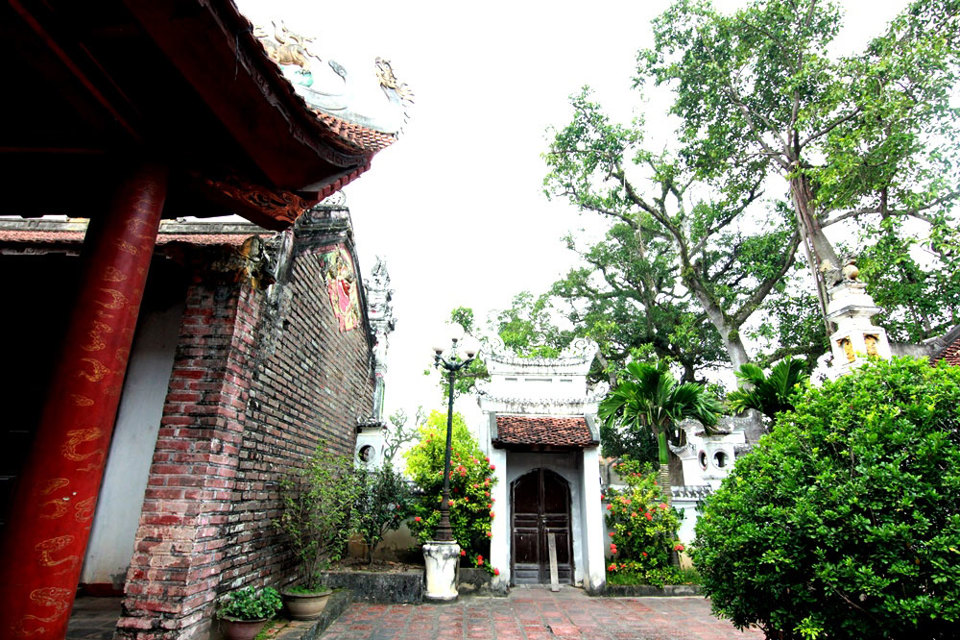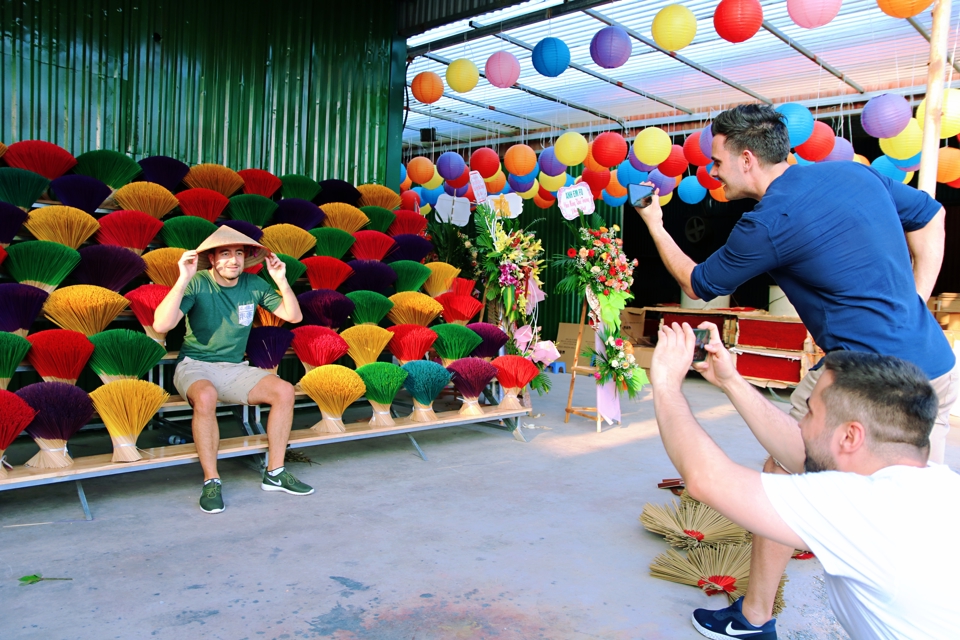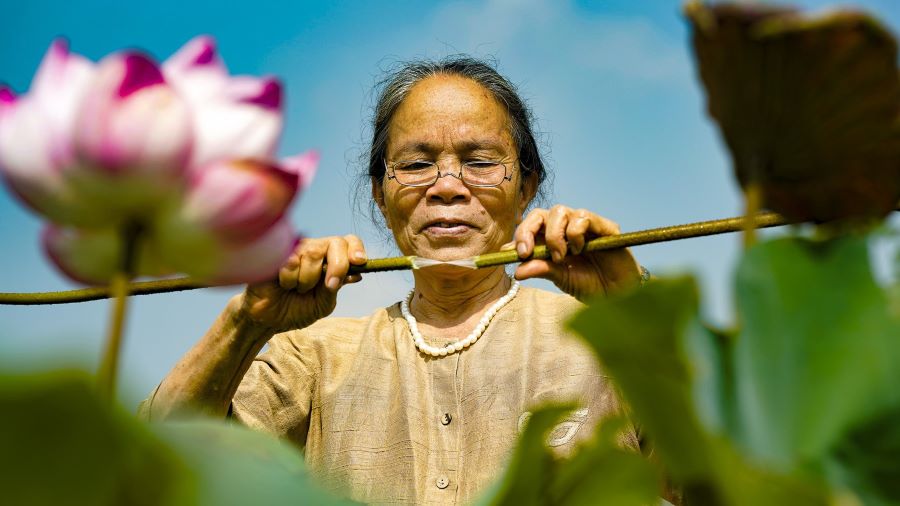New heritage tour to enrich Hanoi tourism offer
The tour will take travelers from downtown Hanoi to explore historical sites and handicraft villages in the suburbs of Hanoi.
The tour, called "Explore the Heritage Road in South of Thang Long", will start mid-month and focus on historical sites and handicraft villages on the outskirts of Hanoi.
As expected, this new tourist route will be announced by the city's Department of Tourism on the occasion of the Vietnam International Tourism Fair 2024, which will be held in Hanoi from April 11 to 14.
| Quang Phu Cau incense-making village is a marvelous tourist attraction in Hanoi. Photo: Le Giang/The Hanoi Times |
Accordingly, the tour will take travelers from downtown Hanoi to explore historical sites and handicraft villages in the suburbs of Hanoi, including Noi Temple in Binh Da village, Binh Minh commune, Thanh Oai district; the famous Quang Phu Cau incense-making village in Ung Hoa district; and Phung Xa weaving village in My Duc district.
Located in Binh Da village, Binh Minh commune, Thanh Oai district, Noi Temple worships the Vietnamese national ancestor Lac Long Quan, under the Hong Bang dynasty of ancient Vietnam in 2825 BC. The bas-relief depicting the boat race festival on the Do Dong River, which Lac Long Quan attended with the marquis and generals of Lac Viet, is the uniqueness of the communal house. The bas-relief was recognized as a national treasure by the Prime Minister in 2015.
In addition, Noi Temple keeps many antiques including annals, inscriptions, a bronze bell, lacquered boards, parallel sets, and tools used in sacrificial rituals from the Ly Dynasty (1054 to 1225) to the Le Trung Hung Dynasty (1533-1789).
| Noi Temple, located in Binh Da village, Binh Minh commune, Thanh Oai district, Hanoi, is a serene and beautiful place. Photo: Ho Ha/ The Hanoi Times |
While exploring the heritage sites in the southern regions of the ancient Thang Long Citadel or modern-day Hanoi, travelers will also have the chance to explore traditional craft villages, including the Quang Phu Cau incense-making village in Ung Hoa District, with all six villages recognized as craft villages.
The six villages of Xa Cau, Quang Nguyen, Upper Phu Luong, Lower Phu Luong, Cau Bau, and Dao Tu have been famous for incense production for over a hundred years. They are the main suppliers of incense to the northern region and the trade is the main source of income for thousands of local households.
The world-famous villages of Quang Phu Cau are an attraction for travelers at home and abroad. Every year in January, as production ramps up for the Lunar New Year festival, the villages of Quang Phu Cau commune become bustling with activity and tons of sticks are produced to meet the country's demand. The whole area becomes magically colourful, making it a must-see for lovers of scenic landscapes.
| Foreign travelers at the Quang Phu Cau incense-making village in Hanoi. Photo: Le Giang |
This is also a photogenic spot for local and foreign photographers. Images of incense sticks arranged evenly on the ground have been captured by talented photographers and have won many major photography awards.
Visitors to the Phung Xa Weaving Village in My Duc District can take part in various stages of mulberry and lotus silk production, such as raising silkworms, spinning and weaving mulberry silk, and weaving silk from lotus fibers.
Meritorious artisan Phan Thi Thuan in Phung Xa Village is believed to be the first artisan in Vietnam to successfully weave silk from lotus fiber. In 2019, Thuan introduced unique lotus silk scarves, shirts, and dresses. This is considered a milestone for the country's silk-weaving industry, paving a new way for its development. Since then, lotus silk has become well-known and popular throughout the country.
| Worm silk is well known around the world, but lotus silk or lotus fiber silk is unique to Vietnam. Hanoi artisan Phan Thi Thuan's passion and creativity have taken the craft to a new level: weaving silk from lotus fiber. Photo: Infonet |
According to Dang Huong Giang, Director of the Hanoi Department of Tourism, the new tourist route is being built and put into operation to create conditions for tour operators to diversify their services and attract more domestic and international travelers to the region.
"It also demonstrates the department's determination to build and improve the quality of tourism products and destinations related to the preservation and promotion of Hanoi's heritage, monuments, and handicraft villages," she said.
This year, Hanoi aims to welcome around 27 million visitors, including 5.5 million foreigners, an increase of 9.2% and 16.4% respectively over last year. Total revenue from tourism is expected to reach around VND103.74 trillion (US$4.22 billion), an annual increase of 11.1%. The average occupancy rate of accommodations and hotels is targeted at 62%.
To achieve these goals, Hanoi is focusing on product development, including experiential tours linked to heritage, relic sites, and traditional villages, as well as culinary, MICE, healthcare, river, and agrotourism in addition to improving government management of the sector.















